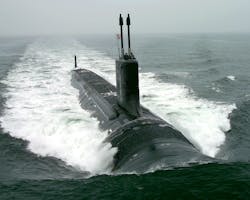Navy asks Lockheed Martin to upgrade and support electro-optical surveillance system for submarine fleet
WASHINGTON – Submarine combat systems experts at Lockheed Martin Corp. will upgrade and support a U.S. Navy electro-optical surveillance system designed for several classes of attack and guided-missile submarines.
Officials of the Naval Sea Systems Command in Washington announced an $8.8 million order on Wednesday to the Lockheed Martin Rotary and Mission Systems activities in Manassas, Va., and in Syracuse, N.Y., to provide kits and spares for the AN/BVY-1 Integrated Submarine Imaging System (ISIS).
These kits and spares will be for the AN/BLQ-10 submarine electronic warfare (EW) system, technology insertion 18 (TI-18), versions.
ISIS provides mission critical, all-weather, visual, and electronic search, digital image management, indication, warning, and platform architecture interface capabilities for Los Angeles-, Ohio-, and Virginia-class submarines, Navy officials say. The system has the potential for installation on Ohio-class ballistic missile submarines and other kinds of submarines.
The AN/BLQ-10 submarine EW system, meanwhile, provides automatic detection, classification, localization, and identification of potentially hostile radar and communications signals at sea. The AN/BLQ-10 is for Virginia-, Los Angeles-, and Seawolf-class fast-attack submarines, Ohio-class conventional guided-missile submarines, and future Columbia-class ballistic-missile submarines.
The ISIS submarine electro-optical surveillance system rolls-up existing components and near-term capabilities into an architecture for inserting future capabilities as they become available, including items leveraged from the Virginia-class submarine photonics program, Navy officials say.
ISIS is a back-fit system to integrate all imaging capabilities on existing Navy submarine classes. It is part of the Navy's submarine Photonics Imaging System, a non-hull-penetrating replacement for existing optical periscopes. The Photonics Imaging System uses a wide portion of the electromagnetic spectrum with advanced daylight cameras, infrared thermal imaging sensors, and communications intercept and electronic warfare support.
The ISIS program seeks to replace the optical light path of existing submarine periscopes with high-definition cameras and fiber optic digital imagery. the project seeks to use infrared cameras for image enhancement, provide active and passive range finding control, and install image enhancement capabilities and analysis tools for real time and recorded imagery.
Related: L-3 to provide electro-optical submarine sensor systems for U.S. attack and missile boats
The ISIS program also will provide Navy submarines with image recording, storage, and recall capabilities, as well as provide the ability to transmit imagery off the submarine to other naval and joint forces.
In-Depth Engineering Corp. in Fairfax, Va., under subcontract to Lockheed Martin, serves as the software development lead for AN/BVY-1 ISIS.
ISIS revolutionizes Navy submarine surveillance capabilities by integrating digital video and still images from devices on a submarine's exterior and presenting real-time imagery and analysis on existing control room tactical displays.
ISIS provides digital image enhancement for data from a modern submarine's photonics mast, which uses optical fiber to move imaging data from a raised mast aboard a submerged submarine through tiny openings in the submarine's hull to tactical displays around the interior of the vessel.
Related: Lockheed Martin to build six electro-optical surveillance systems for Navy submarine forces
The photonics mast replaces or augments the traditional periscope aboard U.S. submarines. The photonics mast not only replaces the large opening in the submarine pressure hull necessary for the optics and hydraulics of a traditional periscope, but also can blend image data from several kinds of electro-optical sensors aboard the photonics mast, including visible-light and infrared cameras.
The ISIS system enables submarine crew members to manipulate a photonics mast with a joystick, while looking at digital video on a computer monitor, and share that video real-time with the submarine's combat team on various displays aboard the vessel.
On this contract modification Lockheed Martin will do the work in Manassas, and Chantilly Va.; Syracuse, N.Y.; Marion, Mass.; and Newport, R.I., and should be finished by March 2023.
For more information contact Lockheed Martin Rotary and Mission Systems online at www.lockheedmartin.com, In-Depth Engineering Corp. at http://in-depthengineering.com, or Naval Sea Systems Command at www.navsea.navy.mil.
About the Author
John Keller
Editor-in-Chief
John Keller is the Editor-in-Chief, Military & Aerospace Electronics Magazine--provides extensive coverage and analysis of enabling electronics and optoelectronic technologies in military, space and commercial aviation applications. John has been a member of the Military & Aerospace Electronics staff since 1989 and chief editor since 1995.
